SHOES AND JOHN Q. PUBLIC
The History and Biography of Both
Vaughn Shoemaker, born in Chicago in 1902, started editorial cartooning at the Chicago Daily News on a fluke when he was 19, and by the time he left that paper 30 years later, he was well on his way to having drawn over a ten thousand political cartoons, and he’d won two Pulitzers, in 1938 and 1947. If it weren’t for his teenage girlfriend, he once explained, he’d have been a lifeguard on the beaches of Chicago all his life.
Shoemaker didn’t do well in school. “I bungled my education in a big way,” he said. “They pushed me through grammar school because they needed the room for youngsters coming along behind me.” He didn’t do any better in high school, so he quit after two-and-a-half years and took up life guarding.
While protecting the beaches of the Windy City, he met “a sensible girl,” and they fell in love. But when Shoemaker proposed, she set him a task: “Sure, I like you,” she said, “but I don’t like you well enough to let you waste my life while you’re wasting yours. Get ready for something! Show me you’re going somewhere!”
That’s when Shoemaker got interested in art and enrolled in the Chicago Academy of Fine Arts to learn cartooning. He almost flunked out. Classes were crowded, and they regularly weeded out the underperformers. And he was “the first to be weeded,” he said.
The director called Shoes (as he would be called in later years) into his office and pronounced his verdict: “Shoemaker, you’d better quit and get yourself a job. You’ll never make a cartoonist in a thousand years.”
But Shoemaker begged the director to let him stay on, and the director agreed. But Shoes needed money, so he went to the Chicago Daily News and hired on as “a sort of office boy in the art department.” It was 1921.
Now and then, he’d try to draw a cartoon. “I was only 19, but I kept plugging, hoping for ‘the break.’ Suddenly, it came.”
Within a single week, a cartooning position on the staff opened up. The chief cartoonist left for a paper in New York, his assistant left to take another position in the paper, and the second assistant left because of illness in his family.
“The boss didn’t think much of my ability,” said Shoes. “He raved in the best newspaper editor tradition—‘You, Shoemaker! Draw something—anything!—until I can look around and get a cartoonist.’”
Shoemaker started drawing cartoons and praying.
“For months, I barely held on to that job,” he said, “—sweating out my ideas for cartoons. The ideas were none too good; neither was the execution. But with God’s help, I managed to stick at it.”
His work improved. Editors liked it. And by 1925, he was the Daily News chief editorial cartoonist. Shoemaker would work at the Daily News for the next 27 years. Oh—and he married the girl, Evelyn, whose salty response to his marriage proposal had set him on the path to a lifelong profession. But he didn’t graduate from the Chicago Academy of Fine Arts.
Shoes is routinely given credit for inventing an editorial cartoon character to represent the average beleaguered middle-aged American taxpayer. Shoemaker’s creation is short because he is ineffectual. He’s pop-eyed because, like all Americans, he’s under a strain. He usually wears a suit and a dumpy hat, and he has a frowzy chewed moustache through which he forcefully expectorates gusts of cigar smoke in exasperation at the vicissitudes of life in America as experienced by a short guy in a floppy homburg.
Shoemaker named his creation John Q. Public, and over the years, John Q. sometimes appeared in other cartoonists’ editoons: with a name, he was more personable than “taxpayer” as his predecessors were typically labeled.
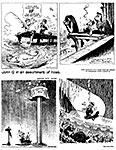 |
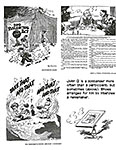 |
And there were predecessors.
The problem with this happy tale of John Q.’s origin is that almost none of it is true. In their book The Ungentlemanly Art: A History of American Political Cartoons, Stephen Hess and Milton Kaplan tell a quite different story—:
“Just as cartoonists have always had some character or symbol to represent the American nation (Uncle Sam), so, too, has there always been a character to represent the American people. In the 1830s and ’40s, he was called Jack Downing after a fictional Yankee peddler created by humorist Seba Smith (1792 - 1868).
“The
present [1960s] form of the symbol was invented by Frederick Opper at
the end of the nineteenth century. Opper’s little man was labeled The Common
People. He also would be known as John Public, and around 1930, Vaughn
Shoemaker, then of the Chicago Daily News, gave him a middle initial:
John Q. Public.” 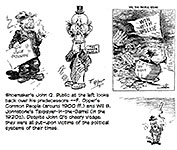
Editoonist (and political cartooning historian) V. Cullum Rogers adds: “Cartoons with figures labeled ‘The Public’ and such have been common at least since the 1890s, but I can't think of one where he's called just ‘John Public’ without a middle initial. Whoever added the ‘Q.’ basically invented the whole name.”
What Shoemaker himself claimed about the character, I dunno. Haven’t been able to find him talking about John Q. anywhere. But he was a man of Christian integrity, and I can’t imagine such a man claiming something as his own when it was actually the accumulated concoction of others.
SHOEMAKER WAS KNOWN around the office as a “gospel cartoonist.” And it was no joke: he was a devout Christian who wasn’t at all timid about expressing his faith, often in his editoons, particularly on the occasions of religious holidays. He wrote a (20 4x6-inch pages) booklet entitled God Guides My Pen. The divine guidance, according to Shoes, began with the big break he got at the Daily News when three of the staff cartoonists left all in one week.
Since then, he said, “I get down on my knees in the office beside my drawingboard every morning before I start to work. I do that every day of my life.
“I wouldn’t dream of beginning work without saying, ‘God, whatever talent I have, you’ve given me and developed for me. Take it and use it. Guide my hand.’
“I prayed for ideas—the all-important stock-in-trade of the cartoonist—and ideas came. Ideas on all subjects. Yes, the going was easier now.”
But the going wasn’t always easy. Shoemaker remembered a Christmas cartoon he did that he had to fight to get published.
“I was floundering around for a real Christmas idea,” he wrote in God Guides My Pen.
He finally settled on a “Bethlehem” picture with the star gleaming down on the manger. It was entitled “The First Christmas Gift,” and Shoemaker had written across the night sky the words of John 3:16:
“For God so loved the world, that he gave his only begotten Son, that whosoever believeth in him should not perish but have everlasting life.”
Shoemaker tried for other ideas, but “God led me back to that Bethlehem drawing, saying, ‘This is it.’ ... The morning came when we had to decide in editorial conference on the Christmas cartoon.”
He took “The First Christmas” to the meeting.
“The drawing was all right, the editors said, but that line, John 3:16—it wasn’t Christmasy. It might offend the non-Christian readers of the News. Couldn’t I find some other line? I fought for John 3:16; it was that or nothing.
“I guess I was pretty stubborn,” Shoes continued, “— but it meant a lot, that text. I was the only man in the room who wanted it, and my heart sank lower and lower as hope faded. Finally, one of the editors said, ‘We’d better take this to the publisher. Let him decide.’
“The
publisher listened patiently to all the obvious reasons why the cartoon should
not be used. He sat and thought it over for a minute, and then he said, ‘Let’s
be sensible. Shoemaker’s right. If it weren’t for John 3:16, there wouldn’t be
any Christmas. It’s a good cartoon. Run it. We need more like it in the News.’ 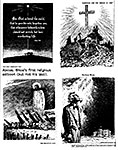
“I finished that cartoon,” Shoes concludes, “and it made the greatest hit of anything I’d ever done. It has been reproduced eight years in succession at Christmas time on the front page of the Chicago Daily News. Now the editors keep asking me, ‘When are we going to have another gospel cartoon?’”
But it wasn’t all easy going after that. And Shoes sometime felt lonely in his faith. One day, he invited another Christian to have lunch with him. Later, they invited other Christians to join them.
Out of that has grown Chicago’s Weekly Gospel Fellowship Club luncheon which now has 800 members and branches in 16 other cities.
“To God goes all the credit for my life,” Shoemaker wrote. “He helps me draw my cartoons. I still talk with Him every morning, and He stays with me all day long. ... He has inspired in me ideas that I never would have had otherwise, ideas that have come to life almost subconsciously in my cartoons. He has given me whatever talent I have.”
BEGINNING IN 1938, the Chicago Daily News published annual collections of selected Shoemaker cartoons. These are handsome, matched set volumes in which Shoemaker’s cartoons are accompanied by essays written by other journalists and historians who put the editoons in the context of events they are commenting upon. The first collection was entitled 1938 A.D.; the second, 1939 A.D.; and so on.
As
far as I know, the Shoemaker books are the earliest book collections of
editorial cartoons in the history of the medium. I have seven volumes of this
series, the next to the last one collecting editoons for 1945 and 1946; the
seventh includes a selection from the fifties and the sixties. That may be the
end of the series. 
In the 1943-44 volume, Lloyd Lewis, then managing editor of the News, undertook to assess the importance of editorial cartooning to a daily newspaper (in italics)—:
The newspaper cartoonist alone has withstood the invasion of the camera. Illustrators, sketch artists, pen-and-ink decorators have all but disappeared from those public prints where once they thrived. Weekly newspapers have succumbed entirely to the photograph. ... Here and there a newspaper or a magazine may feature the paintings of a war-artist but only occasionally and in fugitive fashion, for the speed and realism of the news camera are not to be denied.
Pen-and-ink men who fill pages with comic strips are too far from the news to be thought of as newspaper artists. The old-time sketch man who rushed to a war or a fire or a political convention to show readers his view of the event would never have considered the syndicated comic strip artists as in his world.
Only in politics and sport, two fields in which the average American reader functions with a passion unequaled by citizens of any other nation, does the artist still find a mass newspaper audience. And it is in the political cartoon that the artist as an independent force still hangs on unshaken by the mechanical revolutions that have changed newspapers since the great days of Thomas Nast. ... Somehow the American public, for all its devotion to the newsreel and the film-play, has never quite been ready to give up the opinionated picture entirely.
TODAY, AS WE CONTEMPLATE the ever-shrinking number of staff editorial cartoonists in the nation, it’s a comfort, however vague, to think there was such a time as Lewis writes of.
In another Shoes collection a couple years before, the editor of the News, Paul Scott Mowrer, describes how the political cartoonist works— for which Shoemaker was probably his only model (again, in italics)—:
Other papers may have other ways, but on our newspaper, the cartoonist sits with the editorial conference. Every day, at about ten o’clock, we gather, six or seven or eight of us editors, to discuss the events of the moment, analyze their meaning, weigh and examine them, compare them with similar events of other times and places, and so at last, by the discursive method, decide what editorial comment we may find it appropriate to make. The talk is free and easy, free for all. As it proceeds ... the cartoonist, though at times interjecting a remark of his own, mostly listens.
He sits there, pencil poised above a block of copy paper, waiting for the chance word or phrase that will release the hidden spring in his pictorial mind and start him off. When this happens, he stops listening. The pencil flies over the paper. He is wholly engrossed. In a few moments, he has a sketch ready, the outline of an idea, a sketch which in due course may become the cartoon of the day.
Often, several such sketches result from a single editorial conference. At its end, these sketches, together with others that the cartoonist may have made in the train going home last night or in coming to work this morning, or in his office before the meeting, are submitted to the editor. The most important thing is the drawing. ... When it is agreed on—and with us, it never takes long, for there usually isn’t much to argue about—the cartoonist takes his sketches and goes to his drawingboard to begin his real day’s work, the finished final drawing of the cartoon.
Once more, other papers may have other ways, but on our newspaper, we never ask the cartoonist to draw something he doesn’t want to draw, doesn’t believe in, doesn’t really think he should do; for no man can do his best when his heart is not in the task. Nor do we often venture to suggest an idea. ... Ideas suggested by others rarely fit the methods and personal feelings of the artist. So if anyone wants to know who inspires Mr. Shoemaker’s cartoons, the anser is: Mr. Shoemaker. ...
If you like satire in a cartoon, or wise-cracking, or intricacy, do not seek it here. That is not Shoemaker’s way. There is sometimes a touch of loathing or contempt, but never hatred, never brutality. Respect for valiance, reverence for what is good, pity for those who suffer or sorrow or err, and above all, kindly humor—these are the natural and dominant Shoemaker emotions.
I’ve gone on at this unseemly length about Shoes and his life and profession because I like his drawings. Not that there’s something remarkably stylistic about his drawings. There isn’t. And that’s perhaps what I like about them. Nothing fancy. Just drawn pictures.
The linework is quite ordinary. Lines don’t fluctuate or wax and wane in some distinctive way. They just make the pictures. And his shading techniques are likewise unremarkable. (Although he could pull off a stunning portrait of Abraham Lincoln using grease crayon alone.)
No, the distinguishing aspect of Shoes’ artwork is its relaxed and easy manner. JohnQ and his hayburner, for instance, or the old man patting the kid on the head in the Land of Opportunity. Or John Q the deliriously happy baseball fan riding the World Series off into space.
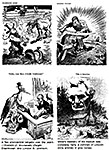 |
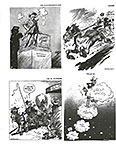 |
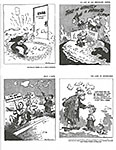 |
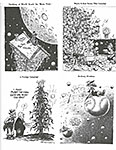 |
Shoemaker’s pictures look like he was having a good time making them. Even on such a somber occasion as Zane Grey riding off to join the Riders of the Purple Sage, or the medic taking Mom and Dad’s place at the side of a wounded solider, it looks as if Shoes was enjoying himself as he drew—or in his deft use of gray tones in a wash he applied to European street scenes.
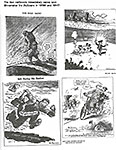 |
 |
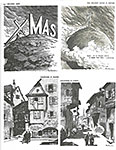 |
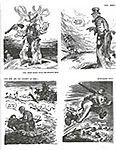 |
 |
Because he was having fun, we were, too.
Shoemaker left the Chicago Daily News in 1952 to take the editoonist job at the New York Herald Tribune. After that, he worked for the Chicago American and its renamed successor Chicago Today. When he retired in 1972, he said he’d drawn 14,000 cartoons.
Shoes lived another two decades—part of the time (if I recall correctly) in Monterrey, California, but mostly in Carol Stream, Illinois, where he died August 18, 1991, of cancer at the age of 89. What he did for the twenty years after retiring, I dunno. I imagine he and God found something worth doing together.
